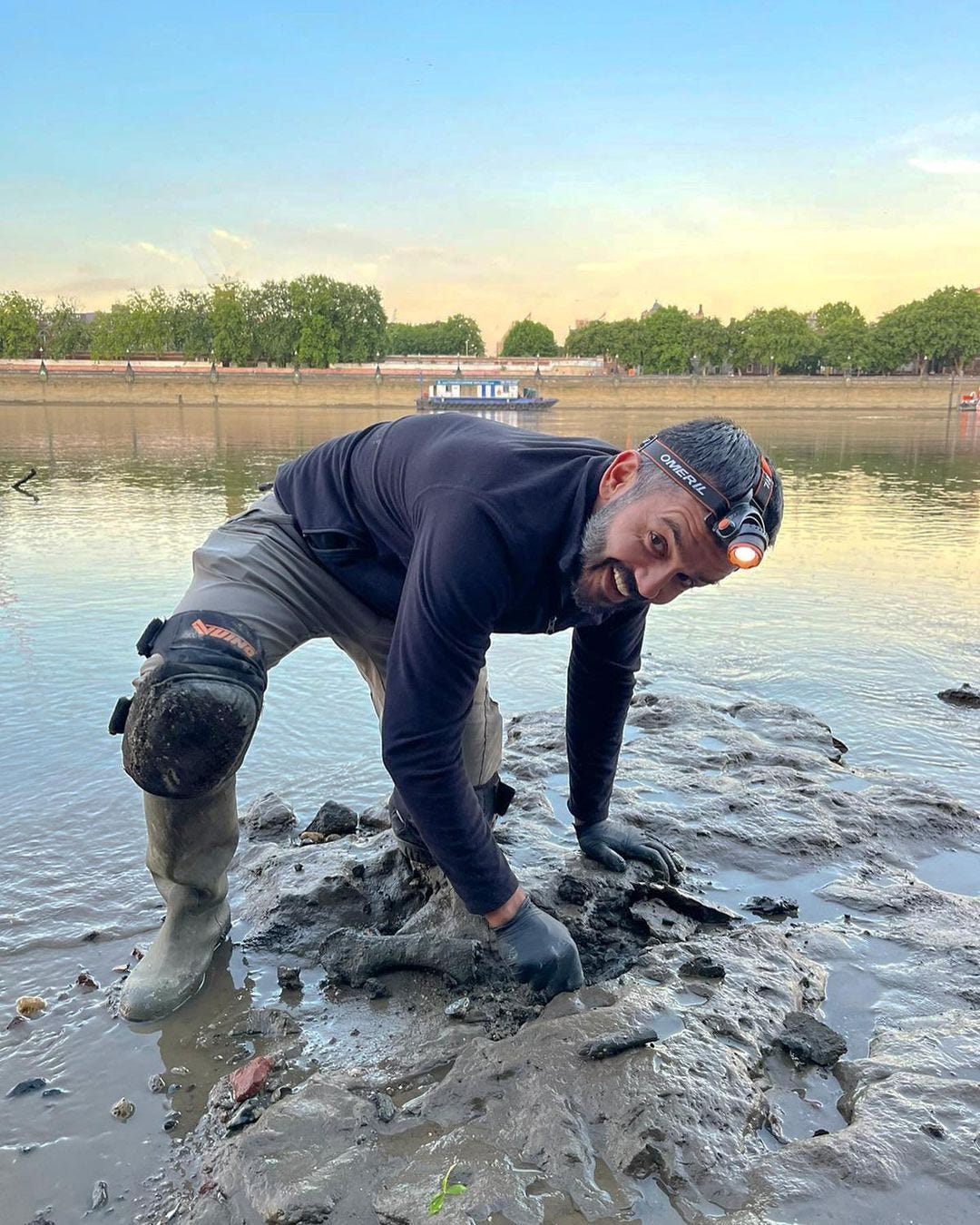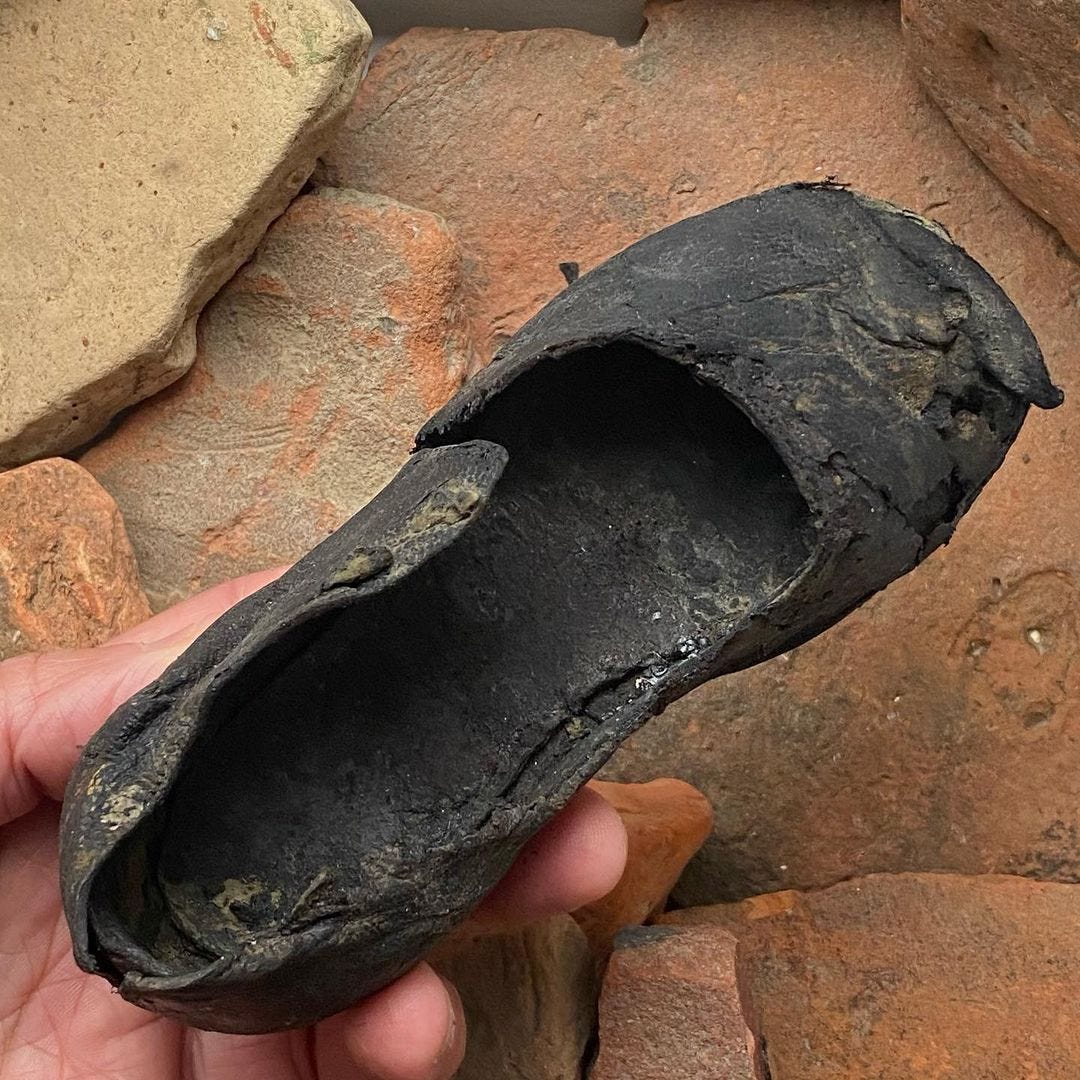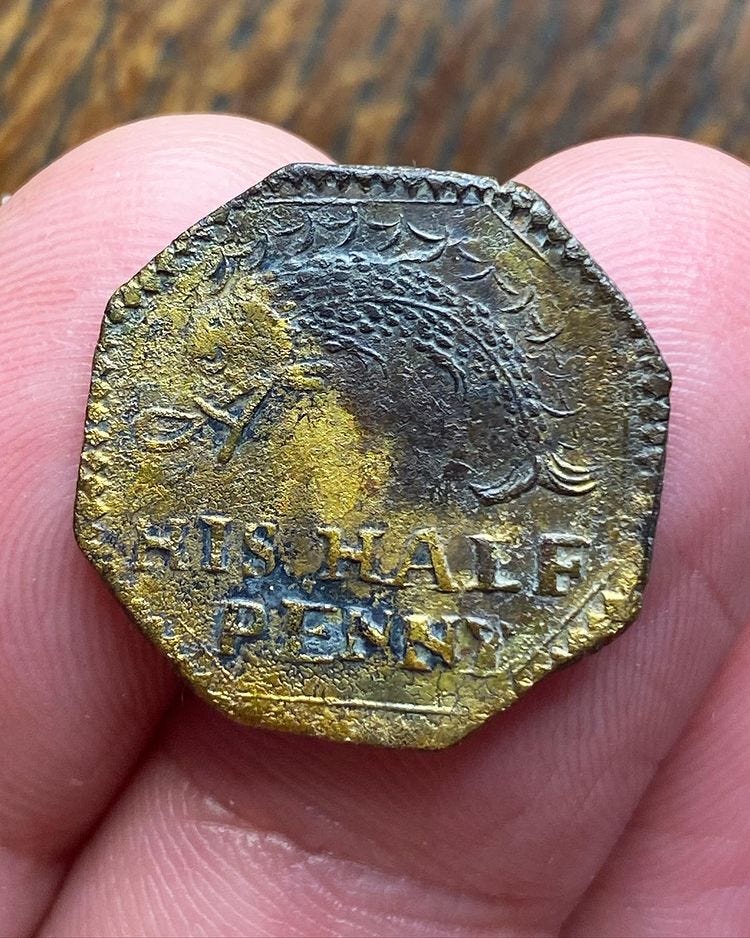Welcome to another special contributor issue of London in Bits. All contributors to LiB are paid a base rate of £200, and that’s only possible because of the support we get from your subscriptions. So, thank you very much for helping us continue to publish independent writing on London.
We’re currently accepting pitches for March and April. If you have an idea for an article then you can send us an outline via londoninbits@gmail.com.
If you were born in the 70s or 80s, then you have likely spent several hours watching the Indiana Jones movies over and over, daydreaming about exploring cursed temples, researching ancient myths and discovering inestimable treasures. I know I did.
My childhood dreams became reality during lockdown, when I discovered that we can all be treasure-hunters in London; and even if we don’t have to face hordes of scorpions or defuse deadly traps, the thrill of discovery is guaranteed.
It’s called mudlarking, and it consists of searching for ancient artefacts on the muddy riverbanks of the Thames

The term ‘mudlark’ has been used since the late 18th century to describe those that scavenged on the Thames foreshore for anything valuable that could be sold or exchanged for essentials. Victorian mudlarks were very poor people, mainly children, that faced an extremely polluted and fetid river hoping to find some pieces of coal, copper nails or buttons. Often too poor to afford shoes or proper clothes, they would spend hours, barefoot in the river even in winter, walking on icy mud and sharp shards of pottery and glass.
Nowadays mudlarks are history-hunting enthusiasts who, in the comfort of their warm wellies and puffer jackets, search for similar items in a much cleaner and healthier river.
Like many others, I discovered this hobby during lockdown. I live next to the river in central London and so the foreshore became the location of my 20 minutes of daily exercise. After the first few outings I noticed small, white, decorated clay cylinders stuck in the mud, and through Google I found out they were Victorian clay pipe fragments.
I was hooked.
I immediately got the required permit and started researching access points to the foreshore. I hadn’t realised that there are almost 100 of them, ranging from comfortable steps to wobbly ladders that are often too scary for my vertigo. Anyone can access the foreshore for a walk, though a permit from the Port of London Authority is mandatory if you want to search and collect anything, and there are specific rules that come with the permit that mudlarks have to follow. For example, some areas are off-limits even to walk on due to their archaeological or security relevance. While in some other zones (the “no surface disturbance areas”) we are not even allowed to disturb a pebble while searching.
In the beginning I would hardly see anyone on the foreshore, so it was often just me and the seagulls sharing a large stretch of the riverbank. However lately, the number of fellow hunters has increased dramatically, probably as a consequence of the extensive social media and editorial coverage of the hobby.

The number of permits issued has rocketed, going from around 200 in 2017 to 5,000 in 2022. With popularity comes both pros and cons. More people searching means more artefacts are potentially recovered before the next wave buries them again for centuries. However, more searchers also means a lower chance for a mudlark to find something before others do; and it makes it more difficult for the authorities to monitor the searching, recovering and cataloguing of those artefacts.
Due to the sudden popularity of mudlarking, in January the Port of London Authority decided to temporarily put the issuing of new permits on hold until the consequences of this intensive activity on the foreshore can be better assessed. But, if you don’t already have a permit and you’d still like to try mudlarking, then don’t worry. Charities like Thames Discovery Programme and Thames Explorer Trust offer guided tours on the foreshore for those looking to dip their toe into the hobby.
What makes the Thames so special?
The river Thames in central London is a unique spot to mudlark for several reasons.
The first one is that it’s a tidal river, with water levels fluctuating twice a day, sometimes by seven meters. It’s only during low tides that the riverbank becomes accessible and can be searched. Most rivers don’t have this exceptional tide range, the Tiber in Rome, for example, is surely home to some incredible treasures but its shore is never exposed.
There are several tidal rivers or beaches in the UK, but what really makes London such a special spot for mudlarkers is that it has been inhabited since prehistoric times. Inevitably, some artefacts from each of those civilisations have ended up in the river.
On very low tides around Vauxhall Bridge it’s possible to spot wooden poles that are part of a prehistoric structure. It was built and utilised over 6,500 years ago, during the Mesolithic period, when the river was much broader and shallower and surrounded by marshes and woodlands. Humans continued to live in the area, as proven by several other artefacts found in the Thames, including a fragment of a human skull that a mudlark found, which dates back to approximately 3,600 BC, during the Neolithic period.
The Romans are considered to be the founders of London because, in 47AD, they built the very first settlement in the area that corresponds to what is now The City. For over 2,000 years people have continued to live and thrive here: building, fighting, loving, hating, gambling, and evolving. Each object found in the Thames whispers the untold stories of these millions of Londoners that came before us.
Some artefacts allow us to investigate the story of the owner in detail, especially when they bear writing or dates. Like posey rings, which are rings engraved on the inside with secret messages between lovers, occasionally including dates and names. In other cases, the stories these objects tell are more generic, but no less fascinating. Like the Victorian child’s shoe I found, miraculously preserved in the mud for over 150 years. The deformation of the sole told the story of a poor child with bowed legs caused by rickets.

If you enjoyed this issue then please consider subscribing. As a subscriber you’ll get issues like this one, our recent Thames issue, and this look at the history of London’s street food delivered direct to your inbox each week.
Zen and the art of mudlarking
The mindfulness of mudlarking is something that most mudlarks, including myself, experience and talk about often.
It’s an unexpected form of therapy in the chaotic heart of city. I put my phone on silent mode to avoid distractions and, from the moment I walk down the steps of a ladder, all I can look at is the mud under my feet. My brain goes into ‘screening mode’, scanning every inch of the surface for specific shapes, textures or colours. All the noise, the worries, the anxieties, the things to do… Everything disappears for few hours (except maybe the hunger, so I make sure I bring some snacks with me every time I’m out searching).
Partly because of its mindfulness qualities, mudlarking is probably the closest I’ve come to experiencing addiction. For me it has become a consistent thought throughout the week. It’s an experience I long for and I often find myself organising my week based on the tides. On a few occasions I have even skipped social events that have clashed with exceptionally low tides. Other days I set the alarm at 4.30am to go mudlarking before work.
At this point you might be asking (as some of my friends and family have), what drives me and others to do this.
It’s not the monetary value of what we find that makes mudlarks so committed. It’s the thrill of anticipation, knowing that there’s a special artefact out there, waiting to be found.
It’s that ecstatic feeling when you pull a roman bone hairpin out from the mud and realise that you are the first to hold that object since the woman who wore it almost 2,000 years ago. It’s the bittersweet melancholy of discovering a medieval pauper ring, a ring made of bone that was exchanged between lovers that were too poor to afford anything more valuable as a token of their affection.
But, most of all, it is the adventure of researching the clues an object holds and unlocking someone else’s story. It’s that privilege of ‘meeting’ someone through an artefact and creating a special bond with the owner just through the act of holding the same object, centuries apart.

An overload of wonder
I was particularly touched by the recent movie The Banshees of Inisherin, in which an older man, living an otherwise uneventful existence on a remote Irish island, feels the urge to leave something behind that he can be remembered for.
Mudlarking represents one kind of answer to that urge because it makes it possible for common, everyday people to be remembered. It doesn’t matter if you weren’t a king or a queen, or didn’t achieve something considered extraordinary. A 16th century mother can be remembered today by unearthing the thimble she used over 500 years ago to stitch and repair the clothes for her family by the dim light of a candle. That accidental dog pawprint found on a Roman roof tile tells the story of a vibrant ancient London, with lively streets where cats and dogs roamed. Much like today.
Mudlarking brings history back to life through everyday objects lost in the river, and experiencing this is an overload of wonder.
There will always be artefacts coming out of the Thames mud, and while ancient objects are unveiled, new objects are becoming buried for future generations to find. Think about that the next time you toss a coin into the Thames to make a wish.
Some good books to read if you want to learn more:
Mudlark'd: Hidden Histories from the River Thames by Malcolm Russell.
Mudlarks: treasures from the Thames by Jason Sandy.
London in Fragments: a Mudlark’s treasures by Ted Sandling.
You can follow Alessio’s finds via Instagram, Twitter and Facebook.



